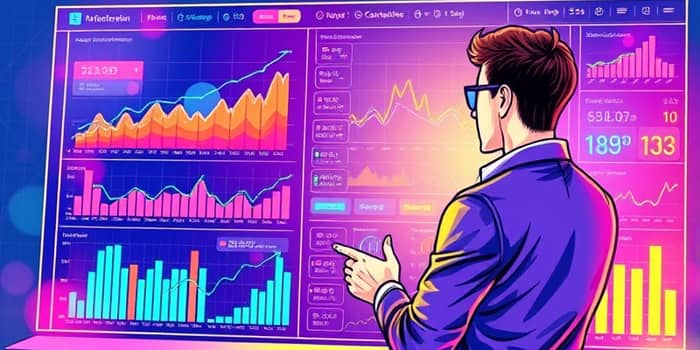In today’s fast-paced world, understanding where your money goes is more critical than ever. A well-designed spending dashboard does not just track expenses—it becomes a compass that guides you toward smarter financial choices. By converting raw data into clear visuals, you can unlock deeper insights and take decisive action.
Understanding the Importance of a Spending Dashboard
A spending dashboard serves as a single pane of glass, bringing together disparate financial data into an integrated view. Whether you manage personal finances or oversee corporate budgets, such a dashboard helps you answer pivotal questions: Where are we overspending? Which categories need adjustment? What trends are emerging over time?
Defining your primary objective of your dashboard early on ensures that every chart and table reinforces your goals. You might focus on tracking monthly household costs, controlling departmental expenditures, or monitoring project-based spending for maximum impact.
Key Metrics and Data Sources
Choosing the right metrics is essential to crafting a dashboard that not only informs but guides strategic decisions. Follow these best practices to select and prepare your data:
- Monthly and annual total expenses for a high-level overview
- Spending by category such as rent, utilities, marketing, and payroll
- Budget vs. actual comparisons to flag variances
- Expense trends over time displayed via trend lines
- Largest cost drivers highlighted for deep dives
- Savings or remaining budget calculations to measure progress
Data can come from bank statements, accounting software, credit card records, or manual logs. Ensuring data quality and consistency—by cleaning duplicates and standardizing entries—lays a solid foundation for accurate reporting.
Designing and Laying Out Your Dashboard
An intuitive layout allows you to grasp key insights at a glance. Aim to fit summary metrics and high-priority charts on one screen, while enabling deeper exploration via drill-downs. Consider these guidelines:
• Use column or bar charts to compare budgeted versus actual spending. • Employ pie or donut charts for category breakdowns. • Implement conditional formatting to highlight overspending with visual alerts, such as red highlights for overages and green for savings.
When choosing tools, balance simplicity with functionality. Excel or Google Sheets may suffice for personal budgets, while platforms like Power BI, Drivetrain, or Glide Apps offer advanced integrations and automation for business environments.
Adding Interactivity and Storytelling
Beyond static visuals, interactivity transforms your dashboard into a living narrative. Filters by time period, department, or project let users customize their view. Drill-down capabilities reveal granular details when needed, without cluttering the main screen.
Frame your dashboard with a clear storyline. Lead viewers through a sequence: “This month our marketing spending exceeded budget by 12%, but digital ad performance improved customer acquisition costs.” Storytelling connects data points, motivates stakeholders, and fosters informed discussions.
- Embed dynamic filters and slicers
- Incorporate real-time data feeds
- Use narrative captions to explain key variances
- automate updates for timely insights
Common Pitfalls and How to Avoid Them
Creating an effective dashboard is not without challenges. Recognizing common pitfalls helps you design a resilient solution:
- Overloading with too many KPIs—stick to top priorities
- Poor data hygiene leading to misleading charts
- Lack of consistency in colors, units, or naming conventions
- Manual data entry that introduces delays and errors
- Neglecting the end user’s needs and technical skill level
By proactively addressing these issues, you maintain trust in your dashboard’s insights and ensure sustained engagement from stakeholders.
Real-World Examples and Use Cases
Spending dashboards can be tailored to diverse scenarios, from personal finance management to executive reporting. Consider the following types:
For a typical household budget, guidelines often allocate 30–35% to rent or mortgage, 10–15% to groceries, and 10–20% to savings. Businesses might focus on customer acquisition cost (CAC) or operating expense ratios to gauge efficiency.
Maintaining and Evolving Your Dashboard
A dashboard is never truly finished. As objectives shift, so should your metrics and visuals. Schedule regular reviews to:
• Remove or replace outdated charts • Add new metrics that align with evolving goals • Update data connections and automation scripts • Solicit user feedback to enhance clarity and usability
By iterating on your dashboard, you foster continuous improvement and keep stakeholders invested in the insights it delivers.
Conclusion: Turning Data into Decisions
Building a spending dashboard is both an art and a science. It requires clear objectives, rigorous data management, thoughtful design, and a compelling narrative. When executed well, such a dashboard becomes an indispensable tool that guides smarter financial decision-making at every level.
Embrace the process: start small, focus on high-impact metrics, and evolve your dashboard as new needs arise. With the right approach, you’ll transform raw numbers into actionable insights and unlock the full power of your financial data.
References
- https://www.drivetrain.ai/post/expense-dashboard
- https://www.youtube.com/watch?v=UWqBlXlKAcc
- https://www.thebricks.com/resources/how-to-create-a-personal-finance-dashboard-in-spreadsheets
- https://www.glideapps.com/blog/budget-dashboard-app
- https://www.f9finance.com/budget-dashboard/
- https://upsolve.ai/blog/financial-dashboard
- https://www.rib-software.com/en/blogs/bi-dashboard-design-principles-best-practices
- https://districtcpa.com/a-comprehensive-guide-to-making-effective-financial-dashboards/










